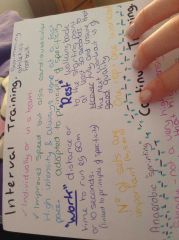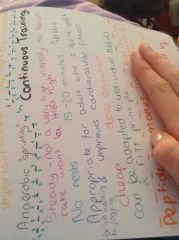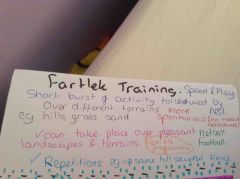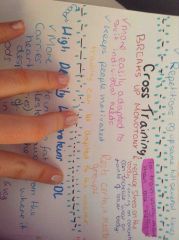![]()
![]()
![]()
Use LEFT and RIGHT arrow keys to navigate between flashcards;
Use UP and DOWN arrow keys to flip the card;
H to show hint;
A reads text to speech;
82 Cards in this Set
- Front
- Back
|
What two types of carbohydrates are there? 50% of your diet |
Complex - starch bananas slower long lasting release Simple - sugars refined biscuit fruit and veg |
|
|
Where's energy stored? |
Sugar is stored in the muscles and liver as glycogen and converted glucose and used to provide energy |
|
|
What percentage of fat should you eat |
30% quick energy release |
|
|
Protein use |
Build muscles and repair damaged tissues Provide energy once carbs have run out |
|
|
Vitamin A |
Carrots helps vision prevent blindness |
|
|
Vitamin B |
Whole meal nuts Releases carbs into the body |
|
|
Vitamin C |
Fruit and veg kiwi Healing and fighting infection Maintains healthy bones |
|
|
Vitamin D |
Fish milk eggs and the sun Absorbs calcium properly |
|
|
Vitamin E |
Veg oil Growth and development |
|
|
Trapezius |
Attached to the head and neck and shoulders Shoulder shrug Rotate shoulder blades Rowing |
|
|
Lattisimus dorsi
|
Sheet of muscle under shoulder blade Pull ups Ab/adducts arm and rotates |
|
|
Imidiate effects on the muscular system |
Increased demand for oxygen and glucose as muscles need more energy to function than at rest More blood needed to remove waste products Lactic acid builds up when there's not enough oxygen available for the muscles |
|
|
Long-term effects on the muscular system |
Increase muscle density strength power size |
|
|
Isotonic contractions |
Allows movement One muscle works the other muscle contracts
|
|
|
Hypertrophy? (1) Benefits? (3) How? |
Increase of muscle mass Better posture Stronger tendons ligaments Decreased risk of injury Happens with progressive overload muscle breaks causes trauma and then rebuilds bigger strong heavier |
|
|
Gastrocnemius |
Plantar-flexion Pushing toes Running |
|
|
Deltoid |
Ab/adducts the upper arm from body Serve in tennis |
|
|
Muscle atrophy |
Loss of muscle mass |
|
|
Interval |
Check methods of training |
|
|
Reasons for warming up |
Prevent injury Improve performance Practice skills Prepare physiologically |
|
|
What effects optimum weight (weight at which a performer performs best at) |
Gender Genetics Bone structure Height Muscle girth |
|
|
Anorexic |
No muscle mass Tired weak bones |
|
|
Obesity |
Limits flexibility Risk of heart disease |
|
|
Overweight |
Weighing more than normal But healthy Not the dangerous one Can be medical can be more muscle |
|
|
Obesity |
Limits flexibility Risk of heart disease |
|
|
Overweight |
Weighing more than normal But healthy Not the dangerous one Can be medical can be more muscle |
|
|
Underweight |
Weighing less than normal but healthy |
|
|
Blood vessels |
Run though out the whole body to allow blood to travel everywhere |
|
|
Par-Q |
Medical examination Medical history Questionnaire on health |
|
|
Low density lipoprotein "bad" |
More fat Build up of plaque in arteries and veins which can restrict blood flow in the arteries so heart attack happens Harder for blood to be pumped increase blood pressure |
|
|
Sedentary lifestyles |
Unhealthy Sitting down a lot Fat |
|
|
High cholesterol |
Caused by diet that consists of LDL diet Only a problem when too high Increased risk of heart disease |
|
|
Performance |
How well a task is completed |
|
|
Fitness |
The ability to meet the demands of the environment |
|
|
Exercise |
A form of physical activity which maintains or improves physical fitness. |
|
|
Health |
A state of complete mental physical and social well-being and not merely the absence of disease or infirmity |
|
|
Performance Pyramid stage |
Quality coaching Training seriously Hard to play two sports Regional Committed to improving skills |
|
|
Main activity |
Consider the timings and level of performance
Training
Game
Competition |
|
|
Cool down |
Gradually reduce heart rate
Remove lactic acid
Static stretching (30 seconds)
Should be relaxing e.g. yoga |
|
|
What is a change in heart rate caused by (Hormone) |
Adrenaline hormone causes Gylycogen to be released by the liver and blood to be delivered away from the digestive system to working muscles |
|
|
Peptide hormones |
Drugs that can cause the reproduction of other hormones |
|
|
Stimulants |
Drugs that have an effect on the central nervous system |
|
|
Cholesterol |
Fatty substance carried in the blood by lipoproteins |
|
|
Interval training |

Yh |
|
|
Continuous training |

|
|
|
Fartlek training |

Back (Definition) |
|
|
Cross training |

|
|
|
High density lipoproteins HDL "good" |
More protein than fat Carries cholesterol away from the heart to the liver where it is disposed of Fruit and veg |
|
|
Stress |
Negative feelings building up over a long period of time
Increases blood pressure
Depression – mood swings |
|
|
Reasons for taking part in sport |
Aesthetic appreciation, challenge, cooperation, competition, friendship. |
|
|
Reasons for taking part in sport Challenge |
Sense of achievement satisfaction |
|
|
Reasons for taking part in sport Cooperation |
Sports I played in teensy need to work together efficiently Needed in daily life Work well with other need to be able to communicate |
|
|
Reasons for taking part in sport |
Aesthetic appreciation, challenge, cooperation, competition, friendship. |
|
|
Reasons for taking part in sport Challenge |
Sense of achievement satisfaction |
|
|
Reasons for taking part in sport Cooperation |
Sports played in teems need to work together efficiently Needed in daily life Work well with other need to be able to communicate |
|
|
Reasons for taking part in sport Competition |
Trying to work the best to beat their personal-best trying to work against the component this makes performer forget about the problems and concentrate |
|
|
Influences for taking part in sport |
People – family, peers, role models (behave).
Image - Fashion, media coverage.
Cultural factors – age, disability, gender, race.
Resources – availability, location, access, time.
Health and well-being – illness, health problems.
Socio economic – cost status. |
|
|
Blood pressure two beating sounds; |
1 systole made by lower chambers contracting and push in blood at high pressure into the arteries and valves close in Max pressure on arteries 2 diastole made by upper Chambers contract in pushing blood to lower chambers more relaxed |
|
|
Benefits for taking part in sport Shmerff |
Self-esteem – physical activity provides a physical challenge if overcome can lead to a sense of achievement which can lead to an increased self-esteem and confidence. Health – people who are physically fit don't get ill so much Mental – anything that is physical is a mental challenger Enjoyment - aesthetic appreciation it's different and you want to be there Relieve stress – distraction from problems of daily life Fitness – toning the body Feeling good – serotonin |
|
|
Pulse pressure |
Difference between systolic and diastolic blood pressures |
|
|
Mental benifits |
Relieve stress Feel good hormone (serotonin) Mental challenge Self esteem boost Aesthetic appreciation |
|
|
Social benefits |
Mix with different people Meet new friends Stay in contact with old friends Develop teamwork |
|
|
Physical benifit |
Contribute to a good physical health Physical challenge can I do it Improve fitness Improve performance |
|
|
Tidal volume |
The amount of air inspired and expired with each normal breath at rest or during exercise |
|
|
Trachea |
Tube it takes into the lungs |
|
|
Tidal volume |
The amount of air inspired and expired with each normal breath at rest or during exercise |
|
|
Trachea |
Tube it takes into the lungs |
|
|
Short-term effects on the respiratory system |
Breathing rate
Oxygen debt due to oxygen that you need but can't get repaid after exercise eliminates waste products |
|
|
Benefits of exercise on the respiratory system. |
Quicker delivery of oxygen to working muscles Co2 removed quicker Vital capacity increases as respiratory system becomes more efficient More Alvioli becomes available for gaseous exchange VO2 mas increased Increased number of blood cells that carry oxygen |
|
|
Smoking negative effects |
Damage to alveoli so Slower gaseous exchange Lungs less stretchy |
|
|
Tendons |
Bone to muscle |
|
|
What happens when muscles contract |
Become shorted and thicker |
|
|
Antagonistic pairs |
When one muscle contracts the other relaxes allows movement |
|
|
Pectorals |
Adduction of upper arm Swimming front crawl |
|
|
Cartilate |
Prevents bones from rubbing |
|
|
Lattisimus dorsi |
Rotates upper arm Butterfly |
|
|
Isometric contractions |
Muscles contract but in a still position Plank |
|
|
Ball and socked joints |
Allows all movement |
|
|
Stroke volume |
The amount of blood pumped by the heart per beat increases work and rest because heart becomes more efficient and stronger |
|
|
Effect a regular exercise on the cardiovascular system |
Decrease heart rate Quicker heart to recovery rate Increased/volume Cardiac output Decrease blood pressure Healthy veins and arteries |
|
|
Cardiac output |
Amount of blood objected from the heart in one minute Cardiac output = stroke volume X heart rate |
|
|
Why is rest essential |
Allows heart to grow Recovery body adapts No of capillaries increase Less prone to illness |

